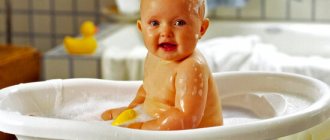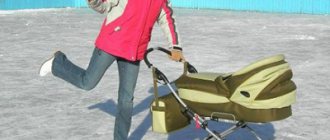Pediatricians advise diving with infants no later than 3 weeks of age, immediately after the umbilical wound has healed. From the moment they are born, babies already know how to hold their breath under water, try to stay afloat, and instinctively move their arms and legs. This is explained by the fact that in the mother’s womb the baby was in a liquid environment. The baby will be pleased to be back in a familiar world and feel familiar feelings and emotions. Therefore, you need to start working with your baby on time. Otherwise, if you wait until 3-4 months, these instincts will weaken, and it will take much longer to teach the child.
The benefits of swimming for newborns
Early swimming is not just a daily hygiene procedure, but a means of developing a baby, helping to master certain skills and building a sense of confidence.
The water environment is a familiar element for babies. While in the mother's belly in a liquid environment, the baby acquired a swimming reflex, which persists until the age of three months. Therefore, bathing is a pleasant and useful activity for a child.
Research has shown that the benefits of infant swimming are as follows:
- Good physical development: “floating” children are less likely to catch colds and learn to crawl and walk independently earlier. Water procedures strengthen the immune system, relieve increased/decreased muscle tone, and prevent rickets;
- Improving the thermoregulation system. Regular swimming exercises develop the ability to maintain a constant body temperature, increase susceptibility to changes in external conditions, reducing the risk of disease;
- Increasing blood hemoglobin by stimulating the release of red blood cells, provoked by difficulty breathing and lack of oxygen during swimming;
- Strengthening the lungs, heart and blood vessels, stimulating blood flow and normalizing blood pressure;
- Formation of correct beautiful posture. Unloading the spine and joints and the effective work of all muscle groups in water develop a strong muscular corset for the spine;
- Cleaning the maxillary sinuses is a good prevention of a runny nose, washing the nose and killing harmful bacteria;
- Strengthening the immature nervous system. Water procedures soothe, improve sleep, increase stamina, improve appetite;
- Training in proper breathing, promoting the development of the bronchopulmonary system and the ability to hold your breath;
- Improving blood circulation in the brain vessels due to the effect on the skin and small blood vessels contributes to the early mental development of the baby;
- Gentle skin massage;
- Socialization of the child: the fear of water, including open bodies of water, disappears, which increases his safety;
- Joint communication strengthens emotional attachment, establishes warm, trusting relationships;
- The main thing is that during the process of active bathing the baby rejoices, smiles, communicates with his parents, making all kinds of sounds, and then sleeps soundly and for a long time.
The benefits of early swimming
Swimming is a valuable activity at any age. Early swimming has its own peculiarities, because it is impossible to explain something to a baby, and he still does not know how to consciously coordinate body movements.
But the classes definitely bring benefits to the baby:
— Swimming helps strengthen and develop the body: it trains the respiratory and cardiovascular systems, improves metabolism. Water has a massaging effect on the body, stimulates nerve endings in the skin, indirectly makes the nervous system more stable, helps get rid of colic and constipation, improves sleep, appetite and balances the emotional background.
— Swimming is a universal method of hardening. Our body loses much more heat in water than in air - this is what the strong hardening effect is based on. The body hones its thermoregulation thanks to water procedures.
— In water, the child moves freely and naturally, he receives a safe load, strengthens the spine, ligaments and muscles, and the internal organs take their correct place. Infant swimming does not allow you to overstrain the ligaments; it eliminates non-physiological movements.
— Movement in water stimulates the development of weakened, lethargic children and relieves stress in tense ones.
— The baby cannot swim alone. He enters the water only with his mother or father (grandmother or grandfather), which means he gets a new experience of interaction with a loved one, a special game and a joint activity that can last for many years and bring joy to an adult and a child.
— Swimming with a child also improves the health of the mother! After all, she also moves in the water, receives a hardening effect, her nervous system and emotional background are balanced. A healthy and satisfied mother is the best thing a child can have. In addition, activities in the pool help diversify life with a baby, bringing new experiences and new acquaintances.
When to start swimming?
A natural question for parents who have seriously decided to master the tricks of swimming for babies in the bathtub is at what time to start swimming in the bathtub. Experts advise from 2-3 weeks of age. By this time, the child will grow up, get used to new conditions and will not lose swimming reflexes.
The umbilical wound can also serve as a reference point. As soon as it heals, you can start swimming with your baby in your home bath. There is no reason for parents to worry: water is the natural environment for a newborn. It is important for adults not to scare the baby, gradually accustoming him to water and mastering new movements.
To be sure, before starting classes, it is better for parents to consult with a pediatrician or swimming coach, and, if possible, conduct the first swim in a home bath together with an instructor specializing in infant swimming. He will give recommendations to parents on swimming techniques, teach how to hold the baby and show simple exercises.
Swimming lessons
You should not start going to the pool for the first six weeks of a baby’s life. Within six weeks, a child with a normal body and blood condition should have a completely healed umbilical cord wound. Until this time, you cannot go to the pool, but you can conduct classes at home. It is also not recommended to visit the pool for women who have undergone a caesarean section or who have had ruptures during labor. They should also wait to go to the pool until the wounds have completely healed.
Any other relative can replace the child’s mother in the pool, and if the parents have the financial means, a coach can work with the baby. Of course, the coach is not a close person to the child, and the child may not feel comfortable. The water in the pool should be warm, but not more than 32 degrees. It is worth visiting only those pools that are intended specifically for infants. Any other pool is simply not suitable, since it is created for adults, without taking into account the characteristics of the child’s body.
Bathroom preparation
Before starting the procedure, you should prepare the bath by washing it first with a regular cleaning agent, then with baking soda/laundry soap and rinsing thoroughly.
Pediatricians do not advise maintaining excessive sterility: strong immunity must be formed by coming into contact with various microorganisms.
Water temperature
The average temperature of the water when bathing should be 34-36 °C; as the child gets used to it, it should be lowered. Before 3 months, the water temperature cannot be less than 32 °C. If the liquid has cooled slightly during swimming, do not add warm liquid and bring it to its original state. This is how it should be, a gradual decrease in water temperature is a good way to harden the body.
An indicator of comfortable conditions will be the baby’s behavior:
- if the dive is accompanied by crying, then the water is too cold;
- if it is actively floundering in the water, the temperature is optimal;
- passivity and relaxation are an indicator of excessively warm liquid.
The newborn must be fed at least an hour before bathing. Swimming should be accompanied by constant communication with the baby.
Harm of infant swimming
Recent European studies prove that indoor swimming pools are harmful to the respiratory system of children. According to confirmed information, the risk of developing respiratory tract diseases in children who have been swimming in pools since infancy is several times higher than in those who have not. All the harm of the pool lies in dangerous chlorine compounds, which enter the baby’s body through the respiratory tract or mouth, accumulating in it and causing dangerous diseases.
A swimming pool for babies should be sterile, but since chlorine is dangerous for an immature respiratory system, it is recommended to treat the room with ultraviolet light and filters with quartz sand. When choosing a pool you should pay close attention to this.
Massage as preparation for swimming
The basis of swimming for infants in the bath is positions on the back and chest with manual support or special devices and independent movement.
It is important to prepare the baby for such actions with the help of massage and special swimming gymnastics, lasting 20-30 minutes. and requiring strict adherence to the execution sequence.
You can massage your baby on a changing table or a regular table. Place the naked baby with his back on a hard surface. Start with light stroking of the limbs from the bottom (hands and feet) up. Turn over and stroke your back and buttocks. Lay on your back and massage your stomach, chest, neck, head. Similarly, following the sequence, knead the child’s body. You should massage the abdomen with four fingers of your right hand, performing movements in a circle clockwise.
infant diving
What parent doesn't want to have a healthy and strong child? It is for this purpose that most mothers and fathers, from the moment the baby is born, think about its development. The question is how to do it correctly and where to start, since the baby himself doesn’t know how to do anything yet?! Despite his appearance of "clumsiness", the child is endowed with reflexes, with the help of which he learns to live and use his abilities to the fullest. This is a sucking reflex, without which it would be difficult for the baby to satisfy the feeling of hunger. Grasping reflex and step reflex, allowing you to correctly “manage” your body parts - legs, arms, torso. And the breath-holding reflex, which is no less important, especially in an emergency situation, when a child collides with water, warning against the danger of instantly choking. Methods for teaching a newborn to swim are mostly based on his unique ability to hold his breath at the right moment. What is the attraction of swimming? Swimming can be called a “3 in 1” sport. That is, the load from exercise is distributed throughout the body, affecting all muscles, even the most hidden and “lazy” ones. At the same time, swimming does not overload the spine. It should be noted that this sport has a beneficial effect on the lungs, promotes endurance of the body, and strengthens the cardiovascular system. Basically, all babies love water procedures and the explanation for this is most likely “the memory of intrauterine life, 9 months in water.” The experience of many parents and teachers has shown that young children very quickly and easily master the technique of swimming underwater, and then it is easier for them to learn to stay on the surface of the water. The only problem in training is that kids are not always happy to dive. In the initial period of teaching a child to swim, from the diving stage, parents will have to make every effort, show enough patience and perseverance. Only thanks to this approach will your child fall in love with the art of diving. Therefore, you should not look at those parents who believe that swimming is not so necessary for children in the past. “Why “torture” a child when he reaches 5 years old and swims like a fish.” The question arises: which conclusion is more correct? Is early swimming better or when the child gets older? 5 arguments for: develops lungs, improves health; eliminates fear of water; strengthens the nervous system, gives healthy, sound sleep; diving as a preventive measure for a runny nose; swimming is a good family holiday. Baby's first steps to swimming How do babies usually bathe? Only in a special baby bath, closing all the cracks and doors. What if it gets cold and the baby catches a cold and gets scared? I would like to immediately note that as soon as the umbilical wound has healed, you can safely “let the child swim” in an ordinary bathroom. It is no longer necessary to sterilize it, the main thing is to wash it well. Whether to add manganese solution to the water is up to you. You can add sea salt or various healthy herbs to the water. Pay attention to the water temperature. If the water is warm, the baby relaxes and wants to sleep; cool water promotes his activity, which is very important when learning to swim. Don’t be afraid to bathe your child with the door open; colds are mainly caused by temperature changes. When you bathed the baby in warm water, “steamed” it, and then brought it into a cool room. Also, do not be afraid that when bathing, water will get into the child’s ears. Otolaryngologists believe that such water entering the ears will never cause replenishment of the middle ear. The time for bathing is determined by the parents themselves, according to the child’s temperament. If your child is active during bathing, extend his bath time by simply adding warm water to the bath. At the end of the bathing procedure, for hardening, rinse the baby with cold water. Do not be afraid to douse from the first days of a child’s life. Let's swim! The very first and best swimming teacher for a child is, of course, the mother. Who knows her baby better than she and feels his every movement. Therefore, communication is very important during bathing. Mom needs to talk to her baby. He, in turn, without understanding a word, feels and understands everything from his mother’s intonation. Immerse your child in water immediately. Observe how your baby likes to swim, on his tummy or on his back, and start swimming from this position. If in the “tummy” position, it is correct to support the baby’s head with your right hand under the chin, the left hand is on the back of the head. For the child’s “bravery” and to protect from water, the mother can hold the thumb of her right hand near her mouth. In this way, movements are made “back and forth” or “figure eight” around the bathroom. You decide on the speed of movement yourself, knowing your child’s preferences. Some people like sudden movements and waves, others like calm swimming. If swimming is performed “on the back”, the support of the arms is performed in the occipital part of the head and lumbar region. You can perform revolutions from the position “on your stomach” to the position “on your back” and vice versa. Often children really like such changes. Diving is a special moment in swimming. To prevent your baby from being afraid of diving, before dipping him into the water, blow gently on his face and spray him with water. At the same time, the child’s “self-defense” is triggered; he closes his eyes and holds his breath for a moment. At this moment, you can safely dip it in water, but not for long. When your baby learns to hold his breath longer, you can even remove the “safety”, your hands, so that he can swim on his own. If classes take place in the pool, swimming as a family, with mom and dad, gives the baby more confidence. Dad can “ride” the baby on his back or stomach, and it’s good to dive for a toy. In a well-known playful way for everyone, diving with the words “Baba sowed peas...”. When the child has “reinforced” all the swimming lessons, you can practice jumping from the side into the water. This is a real delight for children! Special instructors will help your desire and desire to teach your child to swim from the moment of birth. They will provide instructions to parents on this topic, tell them what aids are needed and how to use them (armbands, caps, etc.). An undesirable attribute in training that only interferes with swimming technique is an inflatable ring. Problems and their solutions. Let's swim with pleasure! Despite the attractive properties of water and the adoration of infants for it, a “deafening cry” may occur at the moment of diving. To avoid trouble and make swimming a pleasant pleasure: decorate the bathroom with toys; swim as a family if possible; show tenderness, say a kind word, sing songs; repeat with your child the movements he likes. Author: Anzhelika Kuzmina especially for mamium. Source https://www.mamium.ru
Preparatory gymnastics
After massaging, begin swimming on land, which will help you master the stroke movements.
To do this, you need to perform 10 approaches of the following exercises:
- Wrap your hands around the ankle of a child lying on his back and alternately move his legs up/down;
- With your knees and hips bent, place your baby in frog position. Spread your limbs to the sides, hold, slowly straighten, returning to the starting position;
- With the baby on his back, stretch his upper limbs to the sides. Holding your hands, perform stroke-like movements. Then raise your arms and begin to repeat movements reminiscent of breaststroke swimming;
- Turning the baby over onto his stomach, perform the steps of the two previous exercises.
After performing massage and gymnastics, you should move on to the process on the water.
Newborn swimming procedure
Many experts advise initially swimming exclusively at home in the bathroom, and after one year of age, mastering specialized children's pools.
The basic rules of swimming are strict adherence to the gradual dosing of the procedure as the baby develops. The increase in time for each lesson should be 10-15 seconds. (monthly variation 2 -5 min.), cool the water by 0.5 °C.
The emphasis should be on immersing the head. When training holding your breath through the nasal area in a 1-2 month old baby, lower it into the water for 2-4 seconds. along the mouth opening. A six-month-old child can be allowed to retrieve objects from the bottom of the bathtub from a sitting position, gradually increasing the depth and stimulating the immersion of the head to the eye area.
It is strictly prohibited to sharply increase the duration of procedures and reduce the temperature.
Swimming on your back is relatively easy to learn. The position on the chest requires training of the respiratory system and proper immersion.
We go out into the big water - into the infant pool
If your home activities bring pleasure to you and your baby, your baby is already 2-3 months old and has mastered diving, you can think about moving to the pool. Classes in the pool are led by an experienced instructor. He gives exercises and recommendations for each child, supports the mother and teaches new movements. The first classes last a few minutes, gradually they reach half an hour.
Choose a conveniently located facility, pay attention to the method of water purification, the volume of the pool and the number of mothers with children during the lesson. Give preference to specialized children's pools, where outside adults are not allowed, and all visitors are required to provide medical certificates.
Take an interest in the age group of small swimmers: if the group includes children of a similar age, this is the best option. Noisy yearlings can frighten 3-4 month old babies.
“Mother and Child” groups in swimming pools, as a rule, recruit children from 2 months to 3 years. After this age, children can already study with an instructor alone, especially if they have already learned to float on the water over the years of lessons with their mother.
It is important that swimming brings positive emotions to the child, then both the baby and the mother will benefit from the activity, joy and good memories for life!
Classes without equipment
The exercises are easy to perform and are accompanied by voice commentary or reading special nursery rhymes and jokes. The basis is made up of three swimming positions: shuttle, figure eight, cross, alternating walking and standing.
Here is an approximate set of exercises performed immediately after massage and dry gymnastics:
- Taking the child under your arms with his back to you, gradually enter the water, starting from the lower extremities. While pronouncing the phrase “stand”, hold for 15 seconds. level vertical position. The chin is fixed strictly above the water surface;
- At the “let’s go” signal, walk through the entire bath, making sure that the baby first leans on his feet, and after a while learns to step;
- Signal “stop” again and give 15 seconds. for a break for the baby in a standing position. This is a necessary procedure to prevent motor fatigue;
- Holding with both hands, place the baby on his back with the ears and sternum immersed in water. It's okay if he can sip a little water;
- Perform the “shuttle” exercise, moving from edge to edge of the bathtub and pushing with your feet. Hold the child lightly with your hands, allowing the self-preservation instinct to work. As the baby gets older, use a one-handed support that allows for strokes;
- Place your newborn in an upright position. While saying “stand,” hold the position for 15 seconds, clasping the neck area from behind with your left hand. The right limb of an adult under the chin of a child;
- Using your right hand, place your baby on your chest. Signal with your voice “swim” and, holding it with both hands, move around the perimeter of the bathtub, drawing a figure eight on the water. Using caution, perform 6-8 repetitions and return the child to an upright position for 0.25 minutes.
- Without forgetting to comment on the actions, repeat walking through the bath and resting.
- Do the “Cross” exercise. Holding your baby on his back, slowly make a diagonal sweep from one corner to the other. Alternating between standing and resting, repeat 6-8 times.
You can see more clear and detailed instructions in the video below.
Remember that rest should be equal to half of the entire swimming procedure. Throughout the entire cycle (3-4 minutes), communicate with your child. On average, in one session a child will swim about half a hundred meters and walk 6 m. Do not forget about gradually increasing the duration of the complex.
These exercises can be performed while bathing with your baby in the bathroom. The adult will become a kind of support for the baby. It is convenient to hold it on your knees, clasping the head with your hands, and you can rock it slightly. It is good to place it on the parent’s stomach and chest, fixing the top of the head.
It’s okay if your baby takes a sip of water during class. Innate reflexes will prevent it from getting into the respiratory tract, and coughing and sneezing will help naturally rid the body of unnecessary bacteria. It is important to continue bathing afterwards.
Contraindications to classes
Before starting systematic water procedures, consult your pediatrician. He will explain whether this activity is suitable for your child and identify any limitations. Swimming is contraindicated if you have the following health conditions:
- disorders of the musculoskeletal system, which require fixation of the limbs;
- congenital heart diseases;
- purulent dermatitis;
- colds and viral diseases (after treatment you can swim);
- neurological disorders that are accompanied by seizures.
Remember that you cannot insist and force children to bathe, swim, and especially dive. Such efforts will not add health to the baby, but, on the contrary, will lead to psychological problems.
So, infant swimming is an extremely exciting and extremely useful activity. The child is immersed in a familiar environment, develops the muscular system, strengthens the immune system and learns about the world around him. Babies who started swimming from the first days of life adapt better to the conditions of kindergarten and school. Isn't this a good reason to go swimming with your child?
READ ALSO: Review of popular methods of early child development with video consultations and films -
PS You can search on the Internet for two books by the authors Nikita Yanushchanets and Z.P. Firsov “Swimming before walking” and download for free.
Learning to dive
The diving procedure is complex and necessary for the health and safety of an infant. Teaching this skill should begin with teaching your baby the voice command “dive/dive” and pouring water on his forehead and face.
You need to really dive in the second month of performing a cycle of water procedures and do it from a position on your chest. When swimming in a figure eight, dive every three exercises, saying the command and splashing water in your face. At first, the child will be able to drink a small amount of water, this is not harmful. When the baby is ready reflexively (squints his eyes, closes his mouth and holds his breath), lower him completely under the water for a few seconds.
Are we going to the bottom?
Although babies swim under their mother’s heart all nine months before birth, the baby should be taught to dive before the start of training swims. How to properly carry out the preparatory work? Pour water onto your baby’s face so that it flows from top to bottom, and before doing this, gently say the “magic word,” for example: “Let’s dive!” The baby gradually adapts to the feeling of water on his face. You can also blow lightly on your baby’s face just before you say “Let’s dive!”, and then pour some water on it. This will cause the child to instinctively close their eyes and mouth and hold their breath for a moment.
Swimming accessories
If you are afraid to hold your baby in a filled bath, you can use special devices.
For home use, a bathing cap and circle are suitable.
A cap with inserted foam blocks will greatly facilitate the task for parents, helping to keep the head above the water. When buying a hat, choose cotton fabric. When swimming, be careful not to get water into your ears.
The circle for newborns is an inflatable chamber with a recess for the chin and fixing Velcro. In this case, parents only need to control the little one. Using this accessory allows the baby to move independently and move its limbs. It can be used from birth.
To make bathing fun and useful, add a variety of toys to the bath.
If you have the opportunity to swim with your child in a special children's pool, then it is worth purchasing special underpants and sleeves.
The main condition is not to leave it unattended and constantly monitor the condition of the baby.
Inflatable ring
The inflatable ring was created specifically to make swimming safe and for the child to feel confident. An inflatable children's circle that is worn around the neck is practical. It can be used from the first weeks of a child’s life. An inflatable ring is used to prevent the baby from drinking water while swimming.
The inflatable ring is made on the basis of polymers with a high level of strength. The design of the children's circle provides a special depression for the chin. Some circles have special handles on the surface that allow you to hold your child while swimming. An inflatable ring can consist of several chambers at once. It is important to choose the correct sizes, since an inflatable circle whose circumference does not correspond to the size of the baby’s neck will be uncomfortable. The inflatable ring is attached with special Velcro.
In what cases should you refrain from swimming babies in the bath?
Before you start bathing with an infant, you should consult with your pediatrician, as there are a number of contraindications to water procedures.
You should refrain from them if your baby is diagnosed with:
- inflammatory processes in acute form, accompanied by an increase in body temperature; with elevated temperature;
- diseases of the epidermis;
- presence of wound surfaces;
- purulent inflammation;
- mental pathologies, seizures;
- cardiovascular disorders, congenital heart diseases;
- renal and hepatic failure;
- infections.
You should not carry out water procedures if the baby is crying or nervous.
If distraction with a toy does not work and the tantrum continues, reschedule the activity to avoid unpleasant associations later.
Remember that you cannot:
- deal with a tired, sleepy, hungry child;
- rush things, forcing them to master new elements for which the baby is not ready.
- be in a bad state of mind, nervous: it is important to remain calm
- stop training if the first procedure is unsuccessful.
Remember that a mistake made once can deprive a child of the desire to swim forever.
The main goal of parents is the pleasure and health of the baby.
Swimwear
Water is a more familiar environment for a child compared to air and land, since the baby spent quite a long time in the womb surrounded by amniotic fluid. That is why there are practically no difficulties in teaching a baby to swim. If you start training from the first months of life, then very soon the child will be able to fully swim and even dive.
Water activities promote better blood circulation, strengthen the heart muscles, and improve breathing. Practice shows that most children who go swimming from the first months of life get sick much less. This applies to acute respiratory infections.
The question arises as to what clothes a child should wear while swimming. It is clear that adults, when going to the pool, take with them swimwear or a swimsuit, as well as a special cap. Bathing caps for children are rarely used. If parents want to bathe their child in a cap, then they sew them themselves or simply buy an ordinary cap.
The child must wear a special swim diaper. The thing is that while swimming, a baby who has not yet learned to control his bowel movements can defecate into the water.
It’s not entirely pleasant to swim in water colored by childish “surprise.” If you want, you can wear panties over the diaper, but this is not particularly necessary. Panties can be worn when the child is a little older and learns to express his emotions and needs.
The hat should be just the size of the child's head. You should also pay attention to your panties. They should not put pressure anywhere or restrict the baby’s movements. You should not buy very bright panties for swimming, they can simply fade and stain the water. In addition, bright panties will distract the kids’ attention from the activity.











